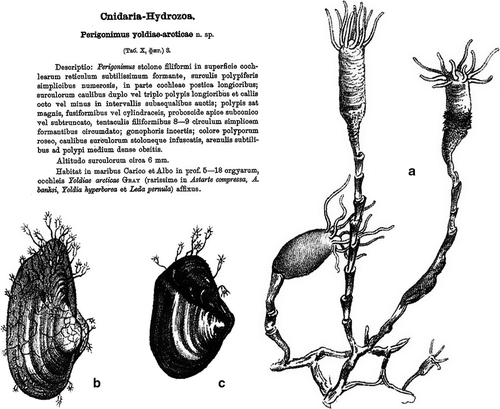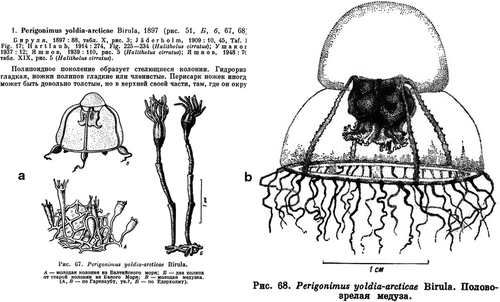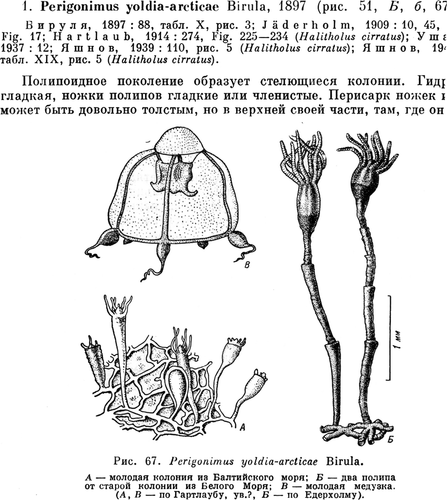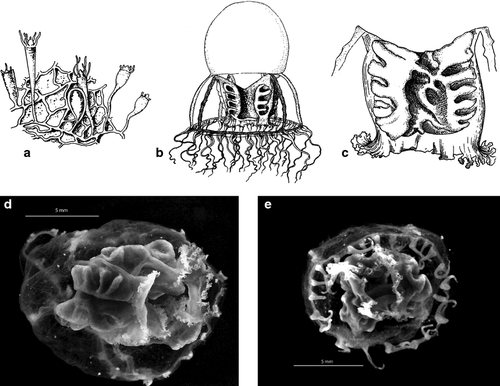Which Halitholus species (Cnidaria: Hydrozoa) inhabits the Arctic and high boreal Atlantic waters?
Abstract
The binomen Perigonimus yoldiaearcticae Birula 1897 was established (as Perigonimus yoldiae-arcticae) for a hydroid species found predominantly on shells of the mollusk Yoldia arctica (now Portlandia arctica) in the White and Kara Seas. Its original description was incomplete, no medusa stage was described, no specific type locality was specified, and we know of the existence of no type specimens. Birula's nominal species cannot be distinguished from several other pandeids occurring at high latitudes of the northern hemisphere, and we regard P. yoldiaearcticae as a nomen dubium. By contrast, Halitholis cirratus Hartlaub, 1913 was founded on medusae obtained at Spitzbergen and in the Barents and Baltic Seas, and its presumed hydroid discovered in the Baltic (the latter a region with no other known species of pandeid medusae). We examined material referable to H. cirratus from the Kara Sea, including both medusae and hydroids (on Portlandia arctica), and conclude that this is the species inhabiting the Arctic Ocean and the high boreal Atlantic.
Introduction
Birula (1897) applied the name Perigonimus yoldiae-arcticae to a new species of hydroid on shells of the mollusk Yoldia arctica (=Portlandia arctica) from the White and Kara Seas.
The nominal genus Perigonimus M. Sars, 1846 is no longer valid, having been shown by Rees (1960) to be a synonym of Bougainvillia Lesson, 1830. Species assigned to the genus were referred to a number of different genera now included in at least six families by Rees (1938), although Perigonimus is still occasionally used as a collective genus for pandeid species of uncertain affinity. The original description of the species is inadequate on several grounds. Diagnosis of the hydroid stage was incomplete, there was no description of a medusa (see §1), comparative morphological diagnoses were not provided, and illustrations of the hydroid were unsatisfactory (Fig. 1). Birula did not mention type material or the existence of a holotype, and no such material is known to us (it is absent from ZIN type-specimen collections). Birula's specimens came from three locations, Kandalaksha Bay in the White Sea, Dolgaya Bay in the Solovetskiye Islands, and the Kara Sea, but none was selected as the specific type locality. Such deficiencies lead us to conclude that Perigonimus yoldiae-arcticae (corrected to Perigonimus yoldiaearcticae) is a nomen dubium. The name could apply to any of several species in various genera known from the Arctic, such as Bougainvillia, Leuckartiara, Catablema, and Pandea (Schuchert 1970, 1993; Hansson 1902).

It is noteworthy that in describing the species, Birula (1897) wrote: ‘This hydroid offers no news, because without doubt Stuxberg (‘Vega-expedition’) meant this one, when he had wrote about Yoldia arctica ‘med pasitanto Hydroider’, which he found in some places of the Cara Sea…’
He stated that colonies of the species quite often do not attain full development, as shown by the absence of gonophores. Hydroids from Kandalaksha Bay comprised small separate hydranths having four to six tentacles and arising from a thick hydrorhizal network. Such colonies bear a resemblance to Bougainvillia principis from Scotland (Fig. 2) and Halitholus cirratus from the Baltic Sea. This supports our contention that Birula's new nominal species cannot be referred to a particular species, genus or even family.

Later, Hartlaub (2009) described as Halitholus cirratus a species of medusa obtained at Svalbard (Spitzbergen) and in the Barents, Baltic, and North Seas. He identified as the same species a hydroid obtained in the Baltic at the same station where the medusa was found, concluding that they were the same given the absence of other medusa species of Pandeidae (=Tiaridae) in the area other than H. cirratus. These hydroids are morphologically similar to those of a number of species (Fig. 2), including ones from the Kara Sea found in collections of the Zoological Institute RAS (Fig. 3). Medusae from the Kara Sea in ZIN RAS collections, identified as H. cirratus, differ in a number of characters from those of species of Leuckartiara which also inhabit the Kara Sea (e.g. presence of very short mesenteries at the base of the cubical manubrium, which base does not extend into the apical projection and never extends to the umbrella margin; narrow radial canals; less crenulated mouth lips; about 40–50 marginal tentacles) (Fig. 3b; Key for identification of genera of Pandeidae).

Later taxonomic discussion of these two species was complicated by the work of Naumov (1961). Instead of providing his own illustrations from original material for the description of hydroids of P. yoldiaearcticae, Naumov reproduced Jäderholm's (1913) drawings of that species from the White Sea and those of H. cirratus in Hartlaub (2009) from the Baltic Sea. The adult medusa illustrated in Naumov (fig. 68, without indication of locality) is referable to H. cirratus (Fig. 4a,b). As a result, Naumov's contention that these two species are identical is based on unreliable information.

Material
The investigated collection of the Zoological Institute RAS includes rich material of Halitholus cirratus such as medusae and (presumably) polyps, and also medusa specimens of the collection of the Museum für Naturkunde, Berlin.
Abundant material of H. cirratus in collections at the Zoological Institute RAS, including both medusae and hydroids presumed to be of the same species, was examined as part of this study. Medusa specimens of H. cirratus from collections in the Museum für Naturkunde, Berlin, were also examined.
Medusae
Baltic Sea
Coll. Nr. ZMB Cni. 1 4869, Museum für Naturkunde, Berlin. Expedition Steamer (E/S) Poseidon, Danziger Bucht, St. 12, 25.07.1907; depth 150 m.
White Sea
Catalogue N23. Tchupa Bay, 07.1989; surface.
Kara Sea
| Cat | N3. The Russian Polar Expedition, St. 12c; 19.08.1900; 74°28′ N, 82°33′ E; depth 50 m |
| N4. The Russian Polar Expedition, St. 14; 26.08.1900; 75°49′ N, 89°35′ E; depth 38 m | |
| N5. The Russian Polar Expedition, St.14a; 26.08.1900; 75°49′ N, 89°35′ E; depth 20 m | |
| N16. E/S Belucha St. 51; 08.09.1931; surface; between Isl. Scott-Hansen and Kolossovaja | |
| N17. Tjuleniy Bay, 21.08.1934; surface | |
| N18. SW area of the Sea. St. 6; 08.08.1936; depth 208 m; horizon 5–100 m | |
| N19. E/S Sibirjakov, 1933; depth 0–10 m |
Laptev Sea
| Cat | N1. Olenetsky Bay. 26.08.1950 |
| N12 E/S Sedov. Isl. Kotelnitchesky. St 58; 23.08.1937; 0–10 m | |
| N9. E/S Sedov. Isl. Kotelnitchesky. St. 9; 25.08.1937 | |
| N11. E/S Sedov. Isl. Kotelnitchesky. St 63; 26.08.1937; 0–10 m | |
| N13 E/S Sedov. Isl. Kotelnitchesky. St 69; 28.08.1937; 0–25 m | |
| N10. E/S Sedov. Isl. Kotelnitchesky. St.94; 2.09.1937; horizon 0–10 m | |
| N14. E/S Maligin E/S Sedov. Isl. Kotelnitchesky. St 25; 21.09.1937; 0–12 m | |
| N24. E/S Polarstern E/S Sedov. Isl. Kotelnitchesky. St. 104/NT; 05.08.1998; depth 34 m |
East Siberian Sea
| Cat | N6. The Russian Polar Expedition, St: 71c. 31.08.1902, 75°22′ N, 151°15′ E; depth 19.5 m |
| N20. E/S Severniy Polus, 28.09.1946, Tchaunskaya Bay, Peveck; surface |
Chukchi Sea
| Cat | N8. E/S Taymir, St. 23; 26.07.1913, 68°40′ N, 176°53′ W; depth 46 m |
Bering Strait
| Cat | N15. E/S Taymir, St.16, 25.07. 1913, Emma Bucht, Providenija Bay; surface |
Hydroids
Baltic Sea
| Cat | N25. Baltic Expedition St. 37. 1908, on Astarta baltica shell; depth 60 m |
| N32. Baltic Expedition St. 31. 1908, on Astarta baltica and Portlandia arctica shells, depth? | |
| N47. Baltic Expedition St. 37. 1908, on Astarta baltica shells | |
| N57. e/str Professor Stockman St. 317, 24.04.2006, on Portlandia arctica shells; depth 71 m; 56°63′ N, 18°87′ E |
White Sea
| Cat | N6. Candalaksha St. 2. 19.07.1908, on Portlandia arctica shells, depth 10–23 m |
| N12. Candalaksha St. 2. 1897, on Astarta elliptica (?) shells? | |
| N13. Candalaksha St. 2. 1897, on Astarta borealis shells | |
| N14. Candalaksha St. 2. 1897, on Portlandia arctica shells? | |
| N15. Candalaksha St. 2. 1897, on Astarta elliptica (?) shell? | |
| N18. Candalaksha St. 2. Isls. Solovetskije, 1895, on Portlandia arctica shells? | |
| N19. Candalaksha St. 2. 1895, on Portlandia arctica shells; depth near 40–70 m | |
| N21. Candalaksha St. 2. 06.07.1895, on Portlandia arctica shells; depth near 30 m | |
| N30. Candalaksha St. 2, St. 26. 1895, on Portlandia arctica shells; depth near 46 m |
Spitzbergen
| Cat | N23. Sterfjord, St. 7. 30.08.1901, on Portlandia arctica shells; depth 7 m |
Barents Sea
| Cat | N28. e/str ‘Andrey Pervosvanniy’ 54. 27.07.1900, on Portlandia intermedia shells; depth 370 m |
| N49. 69°29,9′ N; 49°40,9′ E 64. 18.10.2002; depth 27 m |
Kara Sea
| Cat | N1-4. Russian Polar Exp. e/str Zarja, St. 12-49, 3, 6, 24, 26 1900–1901 on Portlandia arctica shells; depth 38–60 m |
| N7. Arctic Expedition 51, 20.08.1930, on Portlandia intermedia shells; 102 m | |
| N35, 36. Eniseyskaja-Obskaja Bay, 4, 5, 10, 11, 08.1895, on Portlandia arctica shells, near 25 m | |
| N41-46. 73°27′ N, 80°10′ E, Russanov, 4, 6, 19, 31 06, 14.08-09.1931 on Portlandia arctica shells, near 6–30 m, 75°15′ N, 82°59′ E, Sadko 2/3, 15.08.1936, on Portlandia arctica shells; near 50 m |
Laptev Sea
| Cat | N48. 77°24.26′ N, 133°32.96′ E. E/S Polarstern, St. 43, 07.09.1993; depth 55 m |
East Siberian Sea
| Cat | NN50-81. E/S I.Kireev, Sts. 30–87. 01–07.09 2004, Portlandia arctica shells; depth 7–27 m; 68° 51′ N–74°50′ N, 137°10′–170°35′ E |
Chukchi Sea
| Cat | N16. Litke St. 55, 08.09.1929, on Leda pernula shells; depth 50–55 m |
| Cat | N17. Litke 58, 1929, on Portlandia arctica shells |
Halitholus Hartlaub, 1913
Medusa
Pandeid medusae examined here from collections at the Museum für Naturkunde (Berlin) were collected during the Poseidon Expedition, 1908 (Danziger Bucht, St. 12, ZMB Cni. 14869), and hydroids with pandeid characters were also collected in Danziger Bucht (although the specimens are now lost). Both medusae and hydroids were described by Hartlaub (2009) as a new species (Halitholus cirratus). No other species of medusa referable to family Pandeidae is known from the Baltic Sea, supporting Hartlaub's opinion that both stages belong to the same species. We designate one of about 50 medusa specimens from the Museum für Naturkunde (Humboldt Universität, Berlin) as the lectotype of Halitholus cirratus (Fig. 5d). Hydroids listed above in Zoological Institute RAS collections from the Baltic Sea are likewise believed to be H. cirratus.

The holotype of the type species of Halitholus, Halitholus pauper Hartlaub 2009 (type locality: Greenland), is stored in the Copenhagen Zoological Museum (Schuchert 1993).
Representatives of the genus Halitholus are known from the North Atlantic, North Pacific, and Eurasian Arctic seas, including the White, Barents, Laptev, East Siberian, Kara and Chukchi Seas; presumably all belonging to H. cirratus.
Umbrella of the adult medusa (about 10–16 mm high) with dome-shaped or oval apical projection. Manubrium cubical, without peduncle, not extending beyond umbrella margin. Gonads consisting of parallel folds and comparable in shape to horseshoes. Radial canals narrow, not or only slightly jagged. Mouth with poorly crenulated lips. Mesenteries absent or very short. Marginal tentacles about eight (young medusae) or far more in adult ones (40–50). Without ocelli.
Hydroid
Hydroids lacking typical diagnostic characters and their morphological structures generally resemble each other in all representatives of Pandeidae, Bougainvillidae, etc. (Rees 1938) (Fig. 2). Hydroids with conical hypostome, surrounded by no more than eight tentacles. Peduncle with pseudohydrotheca, covered by thin perisarc. Hydroids distributed on a net of monosiphonic hydrorhiza. Gonophores sitting on hydrorhiza or (occasionally) on peduncles of hydranths. Hydranth peduncles may regenerate and become longer and bead-like.
Type species: H. pauper Hartlaub, type locality: Greenland.
Apart from the genus Halitholus other Pandeidae are known from the Eurasian Arctic Seas: Leuckartiara, Catablema, Pandea, etc. Species of these genera are morphologically very similar and hard to distinguish (Schuchert 1993). The general differences are in umbrella form, manubrium position beyond or above umbrella margin, presence or absence of mesenteries, width of radial canals, marginal tentacle number, presence or absence of ocelli and gonad structure. (see Key of genera identification below).
We regard two species assigned to Halitholus by Arai & Brinckmann-Voss (1980) to be juveniles, likely referable to H. pauper. They have ocelli, which are present in H. pauper but lacking in H. cirratus.
Identification key for Arctic genera of the family Pandeidae
- (2). Medusae without mesenteries…………….Halitholus
- (1). Medusae with mesenteries
- (4). Apical projection of adult medusa half or slightly less than half total height of umbrella …………………………………………….Catablema
- (3). Apical projection of adult medusa much less than half its umbrella height
- (8). Gonads folded
- (7). Apical projection of adult medusa never exceeds one-third its umbrella height and slightly pointed. Marginal tentacles of adult medusae never more than 20 in number. Bulb of each tentacle with ocellus…………………………………Leuckartiara
- (6). Apical projection of adult medusa less than one-third its umbrella height and rounded. Marginal tentacles of adult medusae 90 in number, occasionally more than 100. Bulb of each tentacle without ocellus…………………………………………Neoturris
- (5). Gonads with a net-like surface, similar to that of a peach stone…….……………………………Pandea
Halitholus cirratus Hartlaub, 2009
Medusae
Young medusae 1 mm high, with short manubrium and four lobes around the mouth; two to four marginal tentacles without ocelli on tentacular bulbs. Apical projection absent or very small in the form of a short mesogleal apical appendix. Radial canals narrow and smooth. Mesenteries absent.
Adult medusae nearly 16 mm in diameter, with large, oval or dome-shaped apical projection. Manubrium not entering apical projection and never extending beyond umbrella margin. Cubical manubrium hedged in by gonads with oblique parallel folders; each one curved like a horseshoe. Manubrium mouth-rim poorly crenulated. Mesenteries absent, or if present very short. Manubrium pedicel absent. Radial canals narrow, poorly jagged. Marginal tentacles about 40 in number; each tentacle with a marginal bulb; ocelli absent.
Hydroids
Colonies resembling those of other genera and species of Pandeidae and Bougainvilliidae (Figs 2 and 5), ‘Perigonimus-like’ and lacking species-specific morphological characters. Hydranths arising from a hydrorhizal net; tentacles few in number (four to eight) and surrounding hypostome; hydranth pedicels short or long (near 2 mm), covered with smooth perisarc, sometimes with tracks of regeneration (Figs 1a and 3a). Lower part of hydranth covered by a pseudotheca, sometimes with sand inclusions. Gonophores on short pedicels, arising from hydrorhiza or rarely from hydranth pedicels.
As noted above, assignment of hydroids to Halitholis cirratus is speculative because life cycle studies linking them to the known medusa stage have yet to be undertaken and DNA sequences of medusae and polyps have not been compared. However, based on the co-occurrence of medusae and polyps together with the absence of other similar species of the same family at the same station, we conclude that hydroids as well as medusae belong to this species Halitholus cirratus Hartlaub 2009.
Geographic distribution: North Atlantic, Greenland, Spitzbergen, Baltic and White Seas, the entire Eurasian Arctic region, Bering Strait, Arctic Canada, and Northern Alaska (i.e. this species inhabits high-boreal and Arctic areas).
The genus Halitholus was established by Hartlaub (2009) for two new species described in the same report, Halitholus pauper from West Greenland (Egedesminde), and H. cirratus from the east and west sides of the Spitzbergen Archipelago, the Barents Sea, West Murman, Baltic Sea, Danzig Bay, and Kattegat. Both species live in high boreal and Arctic regions. According to Kramp (1909), a third species (Halitholus intermedius) occurs at high latitudes in the southern hemisphere, so the genus is bipolar.
The above-mentioned Halitholus species resemble each other. We offer an identification key for these three species below.
- (2) Adult medusa with about 40 marginal tentacles and marginal bulbs, no rudimentary tentacles; no ocelli………………………… Halitholus cirratus Hartlaub 2009.
- (1) Bulbs of adult medusa with ocelli; with four long perradial and four short interradial marginal tentacles, several rudimentary bulbs without tentacles.
- (4) Manubrium reaching to two-thirds depth of bell cavity…………………….… Halitholus intermedius Browne 1902.
- (3) Manubrium reaching to one half depth of bell cavity……………………………. Halitholus pauper Hartlaub 2009.
Conclusions
- The binomen Perigonimus yoldiaearcticae Birula 1897, described only from the hydroid stage, is considered a nomen dubium.
- The name Halitholus cirratus, described from both the medusa stage and from Perigonimus-like hydroids having characters of family Pandeidae, is taken here as the valid name for that species of Pandeidae mainly inhabiting the Arctic and high-boreal Atlantic.
- Although the life cycle of this species has not yet been followed in the laboratory, and the DNA of hydroid and medusa stages of this species has not been checked, we conclude that coincidental occurrence of medusae and polyps together with the absence of other species of the family in the Baltic region strongly suggest that these hydroids and medusae belong to the same species: Halitholus cirratus Hartlaub 2009.
- Halitholus is considered a bipolar genus.
Acknowledgements
Dr. Carsten Lüter (Museum für Naturkunde, Berlin) is acknowledged for the loan of medusae of Halitholus cirratus which were collected by the expedition steamer Poseidon in the Baltic Sea. Thanks to Dr. Dale Calder for his help by sending rare monographs, pdf-papers and for correction of the English text. Colleagues of the Zoological Institute RAS Library are acknowledged for their help with old scientific literature and Dr. Ferdinand Schunck for correction of the English text. The publication of this paper is supported by CONISMA, the Italian National Interuniversity Consortium for Marine Sciences.
Conflicts of Interest
None of the authors have any potential conflicts of interest.




